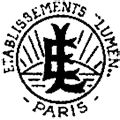


A Brief History of the Marque
1919-1920. Based at Rue de Ridder in Paris, the firm of Charles Combes built a cycle attachment engine, an OHV four-stroke of 118cc and later 143cc, which was integral with a rear wheel which replaced the original. The kit included a 3 litre oil & fuel tank. An example of the motorwheel was part of the famed Guélon Collection.
Lumen also built a complete scooter using the same system. It had floorpan, a wicker seat and rather long handlebars.

A French scooter. The Lumen set can also be adapted to pedal cycles.
Lumen Scooters.
Scooters were represented only by the Lumen, a neat little power unit which is made in a form applicable to attachment to pedal cycles.
A small overhead valve motor of 55 X 50 mm. is attached to the rear forks in such a manner that the crankshaft passes through the hub, the flywheel being on the opposite side to the engine. The drive is through an epicyclic gear.
A circular magneto is used for ignition purposes, and in the case of the cycle attachment, both oil and petrol tank form part of the rear mudguard.
The Motor Cycle, October 1919
Paris Salon, 1919

A neat lightweight having a Lumen engine on the side of the rear wheel and a curved petrol tank which serves as a mudguard.
Two Examples of "Clean" Design from Across the Channel.
IN matters relating to motor cycles the French are the exact antithesis of the Germans. The former are nearly always original, but the Teuton has less initiative, and generally prefers to copy. British and American designers may be said to represent a happy medium.
The revival of the French motor cycle industry revealed more ingenuity and advanced design than have been produced by any other country producing motor cycles, the chief aim being neatness and cleanliness of design generally. As a result unit construction of engine and gear box is fairly general practice, both in sidecar and solo machines.
We give below two examples of French lightweight design, which are of special interest in an issue devoted mainly to light solo motor cycles. The Lumen, with its invisible drive, represents a type of which there are too few machines to suit the pedal cyclist about to take up the petrol-driven vehicle. It may not seem important to the actual motor cyclist that there are no chains or belts in its transmission; the Lumen transmission and the position of the engine may not be so conventional as usual British practice, but there is certainly less mechanism visible, and its apparent simplicity is a point in its favour when the market for which it is designed is taken into consideration.
The Motor Cycle November 18th, 1920.
Sources: La Moto Francaise, Guélon Collection, et al.
If you have a query or information about these vintage French machines please contact us